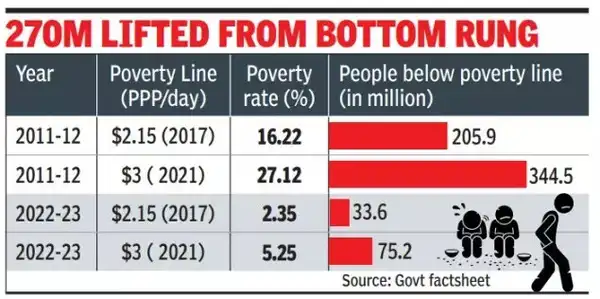Despite increasing the threshold of West Bengal, India takes a big dip in excessive poverty

New Delhi: India’s extreme poverty rate has fallen rapidly in the last decade after the World Bank updated its definition of its international poverty line and has been included in the June upgrade of the functioning.Based on the update, the latest World Bank data showed that the extreme poverty rate had come down from 27.1% to 5.3% in 2022-23 in 2011-12. The number of people living in extreme poverty also fell by 344.47 million in 2011-12 during this period, to 75.24 million in 2022–23. This would mean that around 270 million were out of extreme poverty during the same period.

In a blog, the World Bank stated that the international poverty line for low-income countries has been extended from $ 2.15 per day per day to $ 2.3 per day, and for low medium-income countries it has changed $ 3.65 to $ 4.20 per day and went from $ 6.85 to $ 8.40 for upper middle-age countries.Given India’s inflation rate, between 2017 and 2021, the $ 3 revised extreme poverty line will form a 15% higher range than $ 2.15, expressed in the price of 2021 and will result in 5.3% poverty rate in 2022-23. A new LMIC line of $ 4.20 will be 5% lower for poverty adjusted to the price of 2021 and according to the World Bank, will produce a poverty rate of 23.9%.Using the new poverty line for low medium-income countries (LMIC), which is at $ 4.20 per day, India’s poverty rate fell from 57.7% to 2022-23 in 2011-12 to 23.9%. According to the data available on the World Bank’s poverty and inequality platform, the number of people in extreme poverty declined from 732.48 million in 2011-12 to 342.32 million in 2022-23.Free and subsidized food transfer supported the decrease in poverty, and the gap of rural-urban poverty became compressed. 54% of the five most populous states are very poor, it was said.According to the poverty and equity brief published by the World Bank in April, extreme poverty (living less than $ 2.15 per day) falls from 16.2% in 2011 to 12 to 2.3% in 2022-23, raising 171 million people from this line. Rural extreme poverty decreased from 18.4% to 2.8%, and urban from 10.7% to 1.1%, the rural-urban difference 7.7 to 1.7% points-one 16% annual decline.The poverty report also stated that India has infected in the lower-medium-oriented category. Using the LMIC poverty line per day, poverty fell from 61.8% to 28.1%, leaving 378 million people out of poverty. The April report stated that rural poverty fell from 69% to 32.5%, and urban poverty declined from 43.5% to 17.2%, reducing the rural-urban interval by 7% annually to 25 to 15 percent.Updated World Bank figures are expected to come as a shot for the government and to handle the economy and pursue policies to pursue the inclusive growth and pursue millions out of poverty.Last year, Niti Aayog’s CEO BVR Subhramanyam indicated that the poverty level could be lower than 5% based on initial estimates on domestic consumption expenditure (HCS) data released by the statistics office. The World Bank has stated that in recent years, the scope and quality of the information provided by domestic surveys has improved significantly, especially in low income and low-medium-oriented countries, provide a clear view in people’s welfare and day-to-day life.Many research papers have also indicated a decrease in excessive poverty in the last decade, thanks to a strong growth. A survey released last year estimated that poverty in 2011-12 has come down from 21% to 8.5% and it is reported that chronic poverty has decreased, but there is a significant proportion of people who can slip back into poverty due to “life accident”.The World Bank, which launched the International Poverty Line (IPL) in 1990, has made several updates to incorporate the changing prices and costs, and the latest update was made on 5 June.The first update of the IPL was in 2001, 2008, 2015, later in 2022 and recently this month. This is also the latest update, which also applies to poverty lines for medium -income countries, follows the previous year’s release of a new set of PPP based on the prices collected by the International Comparison Program in 2021.It also shows changes in national poverty lines, which is a major cause of growth, especially for the line that tracks excessive poverty according to the World Bank.




